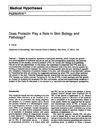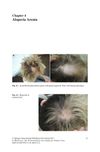 20 citations
,
March 2017 in “Journal of cutaneous pathology”
20 citations
,
March 2017 in “Journal of cutaneous pathology” Shrinking of oil glands in the skin is a key sign of hair loss linked to TNF inhibitor drugs and may improve if the treatment is stopped.
60 citations
,
October 2009 in “PubMed” Intralesional steroid injections are safe and effective for treating severe alopecia areata.
 41 citations
,
September 1991 in “Medical hypotheses”
41 citations
,
September 1991 in “Medical hypotheses” Prolactin may be important for skin growth and immune function.
 December 2016 in “Springer eBooks”
December 2016 in “Springer eBooks” A 45-year-old woman with autoimmune diseases experienced patchy hair loss due to alopecia areata, which has no cure but can be treated, with varying success.
7 citations
,
November 2023 in “Microorganisms” Probiotics may help manage celiac disease by improving gut health and reducing symptoms.


